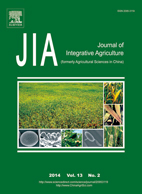|
|
Responses of Ryegrass (Lolium perenne L.) Grown in Mudflats to Sewage Sludge Amendment
BAI Yan-chao, GU Chuan-hui, TAO Tian-yun, ZHU Xiao-wen, XU Yi-ran, SHAN Yu-hua , FENG Ke
2014, 13(2):
426-433.
DOI: 10.1016/S2095-3119(13)60564-X
Sewage sludge amendment (SSA) is an alternative waste disposal technique and a potential way to increase fertility of mudflats for crop growth. The present study aimed to assess the suitability of SSA by assessing the nitrogen (N) and phosphorous (P) uptakes, heavy metal accumulation, growth, biomass, and yield response of ryegrass (Lolium perenne L.) at 0, 30, 75, 150, and 300 t ha-1 SSA rates at various growth stages. The results showed that the highest biomass of ryegrass at seedling and vegetative stages were at 300 and 150 t ha-1 SSA rate, respectively. The increments of ryegrass yield at reproductive stage at 30, 75, 150, and 300 t ha-1 SSA rates were 98.0, 122.6, 88.1, and 61.2%, compared to unamended soil. N and P concentrations in ryegrass increased with increasing SSA rates at all stages except N and P in roots dropped significantly at 300 t ha-1 rate at vegetative stage. The metal concentration for Mn, Cu, Zn, Ni, Cd, Cr, and Pb in shoot of ryegrass at 300 t ha-1 SSA rate increased by 0.63-, 2.34-, 15.02-, 0.97-, 10.00-, 0.01- and 1.13-fold, respectively, compared to unamended soil. However, heavy metal concentrations in shoot of ryegrass were lower than the standard for forage products in China. The study suggested that sewage sludge amendment in mudflat soils might be feasible. However, the impacts of sludge application on edible crop plants and soil environment need further investigations.
|
